 After spending many years in the fitness industry, I often find myself talking about nutrition and how important it is to stay hydrated. A question I hear a lot is, "Am I drinking enough water?" Many people think they are, but the truth is, a lot of them aren't. Those who tend to skimp on water usually say they don't want to keep getting up at night or they just don't like water that much.
After spending many years in the fitness industry, I often find myself talking about nutrition and how important it is to stay hydrated. A question I hear a lot is, "Am I drinking enough water?" Many people think they are, but the truth is, a lot of them aren't. Those who tend to skimp on water usually say they don't want to keep getting up at night or they just don't like water that much.
But here’s the deal: drinking enough water is crucial for your body to work properly. It’s more than just quenching your thirst—drinking enough water is essential for keeping your organs, bones, and skin in great shape! I often tell people that “water is life!”
Let’s look at how staying hydrated affects your health.
Sweating is your body's personal air conditioning system. Whether we’re exercising outdoors on a sunny, hot day or dealing with a fever, our body produces sweat to cool us down. When we sweat, we lose fluids—so it’s important to stay hydrated to replace them.
Digestion is another key player when it comes to hydration. Water helps flush toxins from the body and prevents constipation, helping everything run more smoothly.
Our kidneys are the workhorse of our bodies. These “beans” filter waste products through urine, and they need proper hydration to do their job well. Dehydration can put stress on the kidneys and lead to damage over time.
Muscles and joints also rely on water for lubrication, making it easier for us to move and reducing the risk of discomfort or injury.
And don’t forget about your skin—hydration keeps it looking smooth, plump, and healthy. Drinking water for a more youthful appearance is certainly more affordable than all those creams that claim to make you look 20 years younger!
So, what if you’re not a big fan of plain water? There are still plenty of ways to stay hydrated! Try foods like watermelon or any melons, celery, cucumbers, lettuce, bell peppers, strawberries, oranges, grapes, and tomatoes. You can also get hydration from soup, broth, smoothies, and milk. Just keep in mind—water is still the fastest and easiest way to hydrate quickly.
Now, how much water do you really need? We often hear that we should drink at least 8 oz of water 6 to 8 times per day. That’s a good guideline, but several factors can influence your needs—things like illness, medications, exercise intensity, and even the weather. If you live in the South, the summer months are especially hot and humid, and you’ll likely be sweating more, which means your body will need even more hydration.
In closing, when you reach for that delicious glass of water, remind yourself—you’re drinking to life!

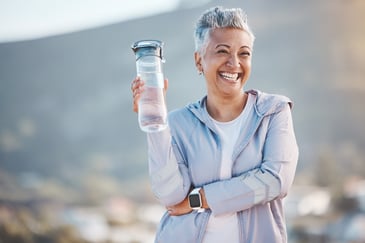 Beginning in the early stages of life, everyone is told to drink water, water, and more water. With everyone instructing individuals to consume more water, what are some methods to increase our water intake? Staying hydrated is vital for the human body to continue to perform activities that we wish to engage in. The human body is roughly fifty percent water, which may emphasize the instruction to consume more water even more than before. We are going to discuss three tips to increase the overall consumption of water so that everyone can reach their desired goals. I encourage you to implement one of the three tips and analyze whether your daily water intake increased. To determine that optimal amount of water your body may need daily, reach out to your primary physician for guidance.
Beginning in the early stages of life, everyone is told to drink water, water, and more water. With everyone instructing individuals to consume more water, what are some methods to increase our water intake? Staying hydrated is vital for the human body to continue to perform activities that we wish to engage in. The human body is roughly fifty percent water, which may emphasize the instruction to consume more water even more than before. We are going to discuss three tips to increase the overall consumption of water so that everyone can reach their desired goals. I encourage you to implement one of the three tips and analyze whether your daily water intake increased. To determine that optimal amount of water your body may need daily, reach out to your primary physician for guidance.
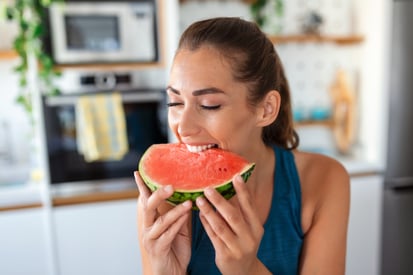 Staying hydrated is an important part of staying healthy and functional during everyday life. Proper hydration helps the body perform several crucial functions including regulating body temperature, keeping joints lubricated, delivering nutrients to cells, and keeping organs functioning properly. Quality hydration also helps to improve quality of sleep, cognitive function, and general mood. Considering all the functions that hydration helps to maintain it’s important to ask a few questions: How much fluid to we need to consume and what are some sources to get it from?
Staying hydrated is an important part of staying healthy and functional during everyday life. Proper hydration helps the body perform several crucial functions including regulating body temperature, keeping joints lubricated, delivering nutrients to cells, and keeping organs functioning properly. Quality hydration also helps to improve quality of sleep, cognitive function, and general mood. Considering all the functions that hydration helps to maintain it’s important to ask a few questions: How much fluid to we need to consume and what are some sources to get it from?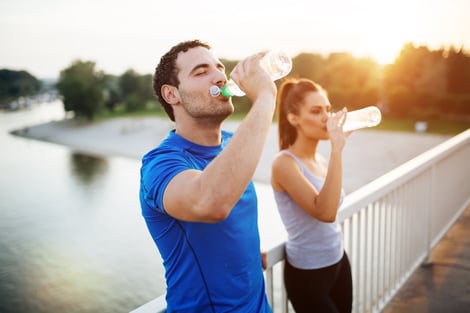 With the warmer summer months, it's the most prominent time when dehydration can become a big health issue and roadblock, especially if you are exercising outdoors. The heat and humidity can make it difficult to maintain a healthy balance of fluids in the body. That's why staying hydrated is not only important for your health but also for your fitness goals.
With the warmer summer months, it's the most prominent time when dehydration can become a big health issue and roadblock, especially if you are exercising outdoors. The heat and humidity can make it difficult to maintain a healthy balance of fluids in the body. That's why staying hydrated is not only important for your health but also for your fitness goals. 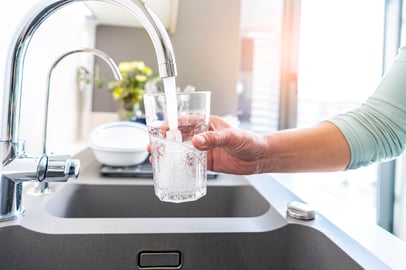 We all know it’s essential to stay hydrated in the summer and that the best way to do so is by drinking plenty of water. But is there a certain type of water, such as “alkaline” water, that offers better hydration? Here’s what our RD has to say.
We all know it’s essential to stay hydrated in the summer and that the best way to do so is by drinking plenty of water. But is there a certain type of water, such as “alkaline” water, that offers better hydration? Here’s what our RD has to say.
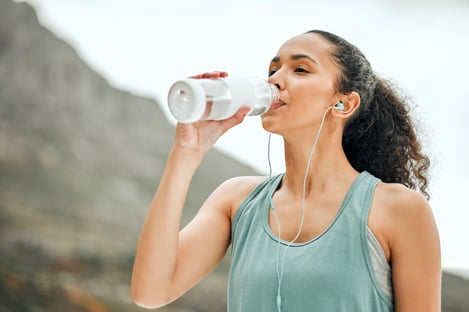 Do you drink enough water throughout the day? The body and all of the systems in it require a certain level of water to preform everyday activities. Staying hydrated can help move waste out, maintain a normal body temperature, and cushion your joints. Here are six tips to make sure you stay hydrated throughout the day.
Do you drink enough water throughout the day? The body and all of the systems in it require a certain level of water to preform everyday activities. Staying hydrated can help move waste out, maintain a normal body temperature, and cushion your joints. Here are six tips to make sure you stay hydrated throughout the day. 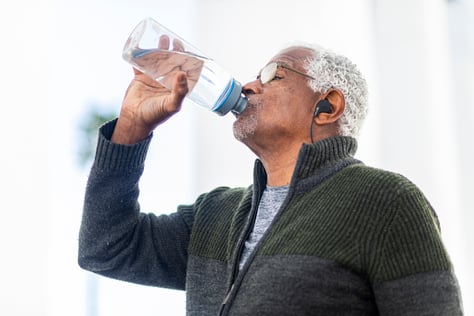 These are both great questions and very important to the older adult population. I hear all the time that people don’t like to drink water because they will need to go the restroom more. This can be an inconvenient especially during the night but in the long term we need to make sure we stay hydrated. Proper hydration is essential in keeping multiple systems of the body functioning properly. Most people need to drink at least three liters of water per day. You can get this water from many different sources including vegetables. If you can get one liter from what you eat during the day with a fruit and vegetable rich diet, then you will only need to drink two liters.
These are both great questions and very important to the older adult population. I hear all the time that people don’t like to drink water because they will need to go the restroom more. This can be an inconvenient especially during the night but in the long term we need to make sure we stay hydrated. Proper hydration is essential in keeping multiple systems of the body functioning properly. Most people need to drink at least three liters of water per day. You can get this water from many different sources including vegetables. If you can get one liter from what you eat during the day with a fruit and vegetable rich diet, then you will only need to drink two liters.
.jpg?width=394&name=GettyImages-962782170%20(1).jpg) I keep finding more and more news stories, magazine articles, social media ads, and even store displays that contain the words “Gut Health.” 10 years or more ago, you never heard that phrase anywhere, but now it’s all the rage. So, why all the buzz? Well, it turns out that research has linked gut health to a variety of functions in your body.
I keep finding more and more news stories, magazine articles, social media ads, and even store displays that contain the words “Gut Health.” 10 years or more ago, you never heard that phrase anywhere, but now it’s all the rage. So, why all the buzz? Well, it turns out that research has linked gut health to a variety of functions in your body.
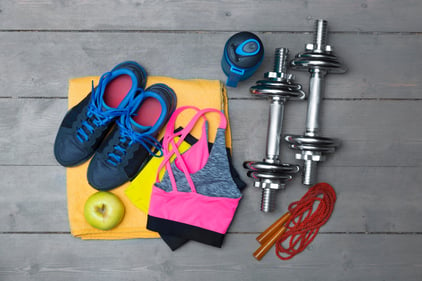 Pick up a new sport or try a new fitness class. Get social! Sign up for a
Pick up a new sport or try a new fitness class. Get social! Sign up for a 
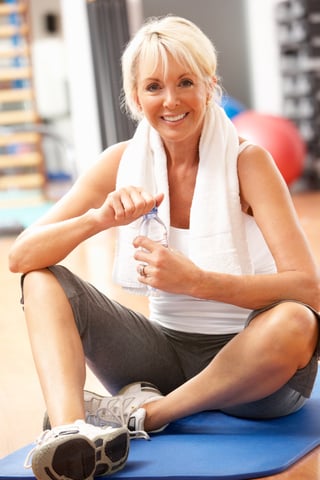 Why You Need to Drink Water
Why You Need to Drink Water